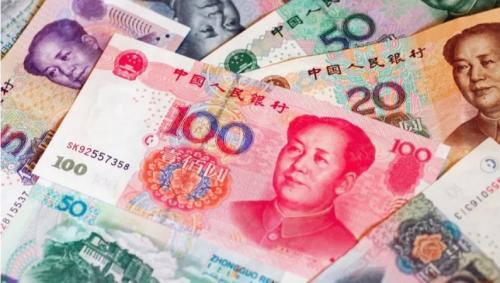The opening of China's financial system (2019 and 2020)
China has announced changes to the foreign ownership conditions in its financial sector by 2020, as part of their strategy to internationalize the Renminbi.
- Análisis

At the World Economic Forum held in July 2019, with the economic war already started, China's Prime Minister Li Keqiang announced that China would make changes to the foreign ownership conditions in its financial sector by 2020. Similarly, restrictions will be reduced in the manufacturing sector, including the automotive industry.
Beijing's signal that it is accelerating the pace of financial opening came in the context of the U.S.-China trade war, which has affected business confidence worldwide, disrupted supply chains and shaken financial markets (see: “The heart of trade warfare: The technological race and transition”, https://www.alainet.org/en/articulo/202191).[1]
The graph shows the stock exchange indices of New York (Dow Jones) and Shanghai (Shanghai Composite) and how since the war, the New York market is highly volatile while in Shanghai there was an initial fall, but it then recovered steadily. What this suggests is that apparently China does not expect bad news while New York does not know what to expect, and believes it is bad news.
The United States and other European countries have long complained that China is blocking foreign access to its fast-growing financial markets and there is no level playing field for investment. What changes are taking place in the regulation and functioning of China's financial system by 2020?
Chinese banks are opening up to foreign investors as part of their strategy to internationalize the Renminbi and to comply with their IMF agreements in this regard. It does not have as a goal either the reduction of limits to foreign ownerships nor of leaving aside risk control in their markets. It is not a consequence of the global economic slowdown pressures as suggested by the trade press. In this sense, the Financial Stability and Development Committee (FSDC) created jointly with the People's Bank of China and three delegated commissions to regulate banking, insurance and securities, will be in charge of supervising monetary policy, managing systemic risks and curbing shadow banking growth. China seems to have learned the Japanese lesson of 1990 and will not let itself be pressured by shadow banks to revalue its currency unnecessarily.
The CEFD published eleven measures for China's financial opening, of which we can highlight:
- Credit rating agencies with foreign investment can rate all kinds of bonds traded on China's interbank market and its exchanges.
- Foreign asset managers can partner with subsidiaries of Chinese banks or insurers to establish foreign-controlled asset management companies.
- The 51% limit on foreign joint ownership of securities, fund management and futures operation companies will end one year earlier than indicated in 2020.
- The Chinese government is committed to making it even easier for foreign institutional investors to invest in the interbank bond market.
The item that facilitates the opening of the stock exchange to foreign investors could be a weak spot, as it was seen in 2014 when the Shanghai market opened through the Hong Kong Shanghai Connect and a coordinated speculative attack from abroad affected the Renminbi (Ugarteche and Luna (2016) www.Obela.org, "The yuan and its conversion into reserve currency" at https://www.alainet.org/es/articulo/174947). That could have been the case in Japan in the 1990 bubble and currency burst.
Internationally, the stock exchanges with the highest number of capitalizations are located in the United States, followed by Japan, China, Europe and India. This list is led by the New York Stock Exchange with US$ 22.9 billion, followed by the NASDAQ with US$ 10.80 billion. The Shanghai Stock Exchange represents approximately one-fifth of the capitalization value of the New York Stock Exchange. International credit rating agencies will be important in an open market. S&P has established itself as the first all-foreign risk qualifier. The major rating agencies, all American, respond to the interests of their clients as seen in the 2008 crisis.
In June 2019, the "Shanghai-London Stock Connect" mechanism was approved, which allows companies listed on the two stock exchanges to issue, list and exchange depositary receipts on the stock market. In this context, in September 2019, the Hong Kong Stock Exchange offered $US 32 billion to acquire the London Stock Exchange (LSE), an offer that was rejected. The next thing was to offer LSE investors, to buy. Among the purposes of these Chinese measures is to internationalize Renminbi.
Evidently, the Chinese government has learned the lesson of the American economic war against Japan and the Yen, held between 1985 and 1990, implementing the necessary regulatory mechanisms to open its financial system, with the purpose of countering exchange and speculative attacks. It will be a challenge to prevent hedge funds from coordinating speculative attacks such as those against the euro after the 2008 crisis and against the Yuan in 2014, when the Shanghai market was opened. In any case, currency speculation is a very powerful weapon in an economic war.
- Oscar Ugarteche, Senior Researcher, IIEc-UNAM, CONACYT / SNI, Coordinator of obela.org
- Larry Vargas, Benemérita Universidad Autónoma de Puebla, member of obela.org
Source: OBELA, Latin American Economic Observatory, IIEc-UNAM, www.obela.org
[1] Julian Baird Gewirtz, “China’s Long March to Technological Supremacy”, https://www.foreignaffairs.com/articles/china/2019-08-27/chinas-long-mar...
Del mismo autor
- El multilateralismo bipolar 08/03/2022
- Bipolar multilateralism 07/03/2022
- What does 2022 bring? Uncertainty 31/01/2022
- ¿Qué trae el 2022? Incertidumbre 31/01/2022
- The most expensive Christmas of the century... (so far) 20/01/2022
- La navidad más cara del siglo (hasta ahora) 20/01/2022
- Lo que pasó en el 2021 10/01/2022
- What happened in 2021 10/01/2022
- Estados Unidos: el elefante en la habitación 08/11/2021
- The elephant in the room 07/11/2021
Clasificado en
Clasificado en:
China-EEUU
- Umberto Mazzei 10/06/2021
- Umberto Mazzei 09/06/2021
- Michael Klare 08/04/2021
- Matthew Ehret 24/03/2021
- Lejeune Mirhan 16/02/2021
